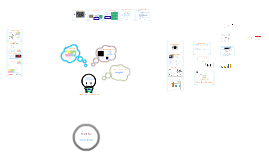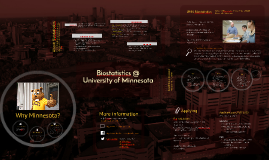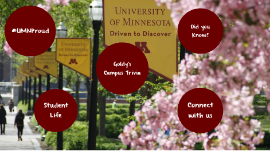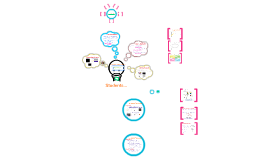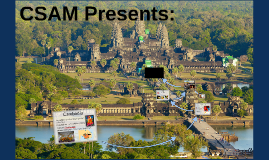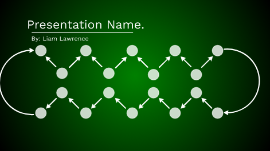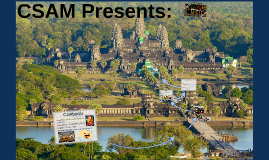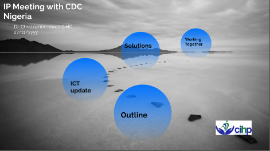UMN Biostatistics
Transcript: Biostatistics @ University of Minnesota What is biostatistics? Academic programs Applicant pool, Fall 2015 Why Minnesota? Disease mapping: What does the distribution of asthma cases in the United States tell us about environmental risk factors for asthma? Personalized medicine: Can we target treatments at groups/individuals with specific risk factors? Statistical genetics: Which combinations of genes put you at highest risk for heart disease? Diagnostic testing: How effective are population screening programs for breast and prostate cancer? More information MS Leading experts in a wide variety of areas, with particular strength in spatial statistics, Bayesian analysis, clinical trials, and statistical genetics. Undergraduate students whose eventual goal is to obtain a PhD are encouraged to apply directly to our PhD program. 209 total applicants MS/MPH 90 applicants, 53 accepted (59%) Averages for accepted students 3.64 GPA 165/155/4 GRE Q/V/AW PhD 119 applicants, 30 accepted (25%) Averages for accepted students 3.84 GPA 166/162/4 GRE Q/V/AW The development and application of statistical methods for solving scientific problems in human biology, public health, and medicine. In recent surveys, UMN has ranked #5-7 out of >40 biostatistics programs in U.S. Mathematical/computing skills Interpersonal/communication skills Curiosity about science Offering the MPH, MS, and PhD Basic math background (same for all programs): Calculus (3 semesters, up to multivariable) Linear Algebra (1 semester) Highly recommended: Courses in probability and mathematical statistics Useful for PhD admission: Real analysis @umnbiostat Faculty on Twitter: @DrJWolfson @JSKoopmeiners @docvock 2 year program Coursework in applied (mostly) and theoretical (bio)statistics, plus public health Written Exam, Master’s Thesis and Presentation Graduates are prepared to work as statistical collaborators and consultants in public and private research institutions. Dynamic students Sally Olander, major coordinator: sally@biostat.umn.edu "The best thing about being a (bio)statistician is that you get to play in everyone's backyard." - J. Tukey Applying 2 year program Coursework in applied (mostly) and theoretical (bio)statistics, plus public health Master’s Thesis, Presentation, and Practicum Graduates are prepared to work as interdisciplinary practitioners of statistics in public health. A "few" faculty research interests: Bayesian analysis, cancer, cardiovascular disease, causal inference, clinical trials, computational biology, diagnostic testing, dynamic treatment regimes, HIV/AIDS, machine learning, medical imaging, pulmonary disease, spatial statistics, sports statistics, statistical computing, statistical genetics, survival analysis. 26 faculty, 65 staff, ~60 students (40 PhD, 25 MS/MPH) Collaborations with research units across campus and around the world. Involved in grants totaling over $150 million. PhD What do biostatisticians do? A highly ranked program A diverse student body spanning multiple cultures and countries. Division of Biostatistics, School of Public Health Minneapolis, Minnesota http://www.biostat.umn.edu Pre-requisites What kinds of problems do biostatisticians tackle? 4-5 year program Courses in theoretical and applied (bio)statistics Written and Oral Exams PhD Thesis and Defense Graduates are prepared to work as independent researchers at universities, government institutions (eg. NIH, CDC) and private companies. About Biostatistics World-class faculty UMN Biostatistics MPH Develop new statistical methods. Collaborate with biomedical scientists to help plan, design, and analyze clinical and population studies. Act as consultants for government, industry, and legal proceedings. Teach and fulfill administrative duties. http://www.facebook.com/umnbiostat What kinds of skills do biostatisticians need? UMN students have won prestigious national and international awards for their research. Some Masters, most PhDs have at least one peer-reviewed scientific publication before graduation.






